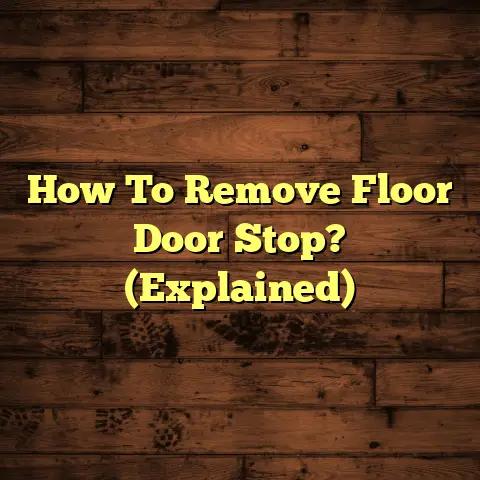Why Use Backer Board For Tile? (7 Install Reasons!)
Choosing the right materials can make or break your tile job.
Let’s dive into why backer board is so important.
Think of backer board as the unsung hero beneath your beautiful tile.
It’s a stable, reliable foundation that ensures your tile looks great and lasts for years.
It’s the difference between a floor that wows and one that ends up cracked and crumbling.
In this article, I’m going to break down the seven key reasons why you should always use backer board for your tile installations.
We’ll cover everything from moisture resistance to cost-effectiveness, so you’ll have all the info you need to make the right choice for your project.
Let’s get started!
Section 1: What is Backer Board?
Okay, so what exactly is backer board?
Well, simply put, it’s a tile underlayment.
It’s a specialized panel designed to create a solid, stable, and moisture-resistant surface for tiling.
Now, you might be thinking, “Can’t I just tile over plywood or OSB?”
And the answer is… technically, you could.
But should you? Absolutely not!
Plywood and OSB are wood-based.
They expand and contract with moisture.
This can lead to cracked tiles and a whole lot of headaches.
Backer board, on the other hand, is made from materials that are far more stable and moisture-resistant.
There are a few different types of backer board, and they each have their own pros and cons.
Let’s take a quick look:
Cement Board: This is the most common type.
It’s made from cement, reinforced with fiberglass mesh.
It’s incredibly strong and water-resistant.
Brands like Durock and HardieBacker are popular choices.
* Foam Board: This type is made from a lightweight foam core with a waterproof coating.It’s easy to cut and install, and it provides some insulation.
Wedi board is a well-known brand in this category.
* Glass Mat Gypsum Board: This is a gypsum core board faced with coated glass mats.It’s moisture resistant and lightweight, making it easy to handle and install.
I usually recommend cement board for most applications, especially in wet areas like bathrooms and showers.
It’s just the most reliable and durable option, in my experience.
Section 2: Reason 1 – Moisture Resistance
Alright, let’s get to the first, and arguably most important, reason to use backer board: moisture resistance.
Think about where you’re most likely to be tiling: bathrooms, kitchens, laundry rooms.
What do these places have in common?
Moisture!
Water is the enemy of any flooring system.
If moisture gets underneath your tile, it can cause all sorts of problems.
Mold and mildew growth is common.
It can compromise the structural integrity of your subfloor.
And, as I mentioned earlier, it can cause your tiles to crack and pop.
Backer board is designed to resist moisture penetration.
Cement board, for example, is virtually waterproof.
Foam board has a waterproof coating that prevents water from seeping through.
In contrast, plywood and OSB are like sponges.
They soak up moisture like crazy.
I’ve seen countless tile jobs ruined because someone tried to save a few bucks by skipping the backer board.
It’s just not worth the risk.
Here’s a scenario: Imagine you’ve just finished tiling your bathroom floor. It looks amazing!
But a few months later, you notice some dark spots around the edges of the room.
You pull up a tile and discover mold growing underneath.
The plywood subfloor is rotting away. Now you’re facing a major (and expensive) repair.
That’s why backer board is so crucial.
It’s like an insurance policy against moisture damage.
It protects your investment and gives you peace of mind.
Section 3: Reason 2 – Strength and Durability
Next up, let’s talk about strength and durability.
Your tile floor needs to be able to withstand a lot of abuse.
Think about all the foot traffic, dropped objects, and heavy furniture it has to endure.
Backer board provides the necessary structural support to keep your tile floor looking great for years to come.
Cement board, in particular, is incredibly strong.
It can handle heavy loads without cracking or flexing.
I’ve used it in commercial applications where there’s constant foot traffic and heavy equipment, and it holds up like a champ.
Foam board is a bit less strong than cement board, but it still provides excellent support for most residential applications.
The key is to choose the right thickness of backer board for your specific needs.
For most floor applications, I recommend using at least 1/2-inch thick cement board.
For walls, you can usually get away with 1/4-inch thick board.
Now, let’s compare backer board to other materials.
Plywood and OSB are relatively weak and prone to flexing, especially when they get wet.
This can cause your tiles to crack and become loose over time.
According to the Tile Council of North America (TCNA), using an improper underlayment can lead to tile failure within just a few years.
Backer board, on the other hand, is designed to last for the life of your tile floor.
It’s a long-term investment that will save you money in the long run.
Section 4: Reason 3 – Easy Installation
Okay, I know what you’re thinking: “Backer board sounds great, but is it hard to install?”
And the answer is… not at all!
In fact, I find it to be easier to work with than plywood or OSB.
Here’s a quick rundown of the basic installation process:
- Measure and Cut: Use a utility knife or a circular saw with a diamond blade to cut the backer board to the desired size.
Score and snap for straight lines. - Apply Thin-Set Mortar: Spread a layer of thin-set mortar onto the subfloor using a notched trowel.
- Install the Backer Board: Place the backer board onto the mortar bed and press firmly.
- Fasten the Backer Board: Use backer board screws to attach the board to the subfloor.
Space the screws every 6-8 inches. - Tape the Seams: Use fiberglass mesh tape and thin-set mortar to tape the seams between the boards.
That’s it! It’s a pretty straightforward process.
The key is to use the right tools and techniques.
A circular saw with a diamond blade will make clean, accurate cuts.
A notched trowel will ensure that you get a proper bond between the backer board and the subfloor.
And backer board screws are designed to resist corrosion and provide a strong hold.
One tip I always share with my clients is to stagger the seams between the backer board and the subfloor.
This will help to prevent cracking.
Another tip is to pre-drill the screw holes to make it easier to drive in the screws.
I’ve seen DIYers struggle with backer board installation because they tried to skip these steps.
Trust me, it’s worth taking the time to do it right.
Section 5: Reason 4 – Improved Tile Adhesion
Let’s talk about adhesion.
You want your tiles to stick to the floor, right?
Of course, you do!
Proper tile adhesion is essential for a long-lasting, beautiful tile floor.
Backer board provides an ideal surface for tile adhesives to bond to.
Cement board, for example, has a rough, porous surface that creates a strong mechanical bond with the thin-set mortar.
This means that the mortar can really grip onto the backer board.
Foam board has a special coating that is designed to promote adhesion.
The science behind adhesion is pretty simple.
The more surface area there is for the adhesive to grip onto, the stronger the bond will be.
That’s why a rough surface is better than a smooth surface.
Plywood and OSB have relatively smooth surfaces, which makes it harder for the mortar to bond properly.
Over time, this can lead to tiles popping or cracking.
I’ve seen countless examples of this.
I once had a client who tried to save money by tiling directly over plywood in his bathroom.
Within a year, the tiles started to come loose.
He ended up having to tear out the entire floor and start over.
He learned his lesson the hard way.
Proper adhesion is also important for preventing moisture from seeping underneath the tiles.
If the tiles are not properly bonded to the subfloor, water can get in and cause all sorts of problems.
So, if you want your tiles to stay put, use backer board.
It’s the best way to ensure proper tile adhesion.
Section 6: Reason 5 – Thermal Resistance
Here’s something you might not have thought about: thermal resistance.
Backer board can actually help to insulate your floor.
This is especially beneficial if you have a heated flooring system.
Heated floors are becoming increasingly popular.
They’re a great way to add warmth and comfort to your home, especially in colder climates.
But if you don’t have proper insulation underneath your tile, you’ll be losing a lot of heat.
Backer board can help to prevent this.
Foam board, in particular, has excellent thermal insulation properties.
It can help to keep the heat from escaping through the floor.
Cement board also provides some insulation, although not as much as foam board.
The key is to choose the right thickness of backer board for your specific needs.
For heated floors, I recommend using at least 1/2-inch thick foam board.
This will provide the best possible insulation.
Now, let’s talk about energy efficiency.
If you have a heated floor, you’re probably paying a lot of money to heat it.
By using backer board to insulate your floor, you can reduce your energy bills.
You’ll be using less energy to heat your floor, which will save you money in the long run.
It’s a win-win situation.
I always recommend backer board for heated floor systems.
It’s a simple, cost-effective way to improve the performance and efficiency of your heating system.
Section 7: Reason 6 – Versatility
Versatility is another key benefit of backer board.
It can be used in a wide variety of applications.
It’s suitable for all types of tiles, including ceramic, porcelain, and stone.
It can be used on floors, walls, and countertops.
It can be used in kitchens, bathrooms, laundry rooms, and just about any other room in your house.
I’ve even used it in outdoor applications, such as patios and decks.
The key is to choose the right type of backer board for your specific needs.
Cement board is the most versatile option.
It can be used in just about any application.
Foam board is a good choice for areas where weight is a concern.
It’s also a good choice for areas where insulation is important.
I’ve used backer board in countless projects over the years.
I’ve tiled entire bathrooms using cement board on the floors and walls.
I’ve installed heated floors in kitchens using foam board.
I’ve even created custom showers with intricate tile designs using backer board as the foundation.
The possibilities are endless.
Backer board is a versatile material that can be used to create beautiful, durable tile surfaces in any room of your home.
Section 8: Reason 7 – Cost-Effectiveness
Finally, let’s talk about cost-effectiveness.
I know what you’re thinking: “Backer board sounds expensive.”
And it’s true that it costs more than plywood or OSB.
But in the long run, it’s actually a more cost-effective option.
Here’s why:
Backer board is more durable than plywood or OSB.
It will last longer and require less maintenance.
This means you won’t have to replace your tile floor as often.
Backer board is also more moisture-resistant than plywood or OSB.
This means you’re less likely to have problems with mold and mildew.
You won’t have to spend money on repairs due to water damage.
Backer board improves tile adhesion.
This means your tiles are less likely to crack or pop.
You won’t have to spend money on replacing damaged tiles.
According to a study by the National Association of Home Builders (NAHB), the average cost of repairing a tile floor due to moisture damage is over \$1,000.
By using backer board, you can avoid this expense.
Here’s a simple cost comparison:
As you can see, backer board costs more upfront, but it lasts much longer.
In the long run, it will save you money.
I always tell my clients that backer board is an investment in their home.
It’s an investment that will pay off in the form of a beautiful, durable, and long-lasting tile floor.
Conclusion
So, there you have it: the seven reasons why you should always use backer board for your tile installations.
Let’s recap:
- Moisture Resistance: Protects against mold, mildew, and water damage.
- Strength and Durability: Provides structural support and prevents cracking.
- Easy Installation: Simple to cut, install, and fasten.
- Improved Tile Adhesion: Creates a strong bond between the tile and the subfloor.
- Thermal Resistance: Insulates your floor and improves energy efficiency.
- Versatility: Suitable for all types of tiles and applications.
- Cost-Effectiveness: Saves money in the long run by preventing repairs and replacements.
Backer board is an essential component for any successful tile installation.
It’s the foundation of a beautiful, durable, and long-lasting tile floor.
Don’t skimp on this crucial step.
Choose backer board and enjoy your tile floor for years to come.
Thanks for reading! Happy tiling!





